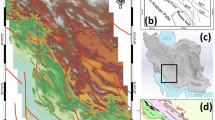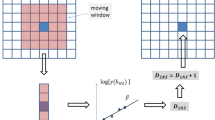Abstract
A fractal dimension (FD) indicates the ability of a set of structures to fill the Euclidean space where it is embedded. For habitat boundaries, FD is bound to a plane, thus 1 ≤ FD ≤ 2. FD is low for simple shapes and increases as patches become more irregular. Some authors have found that FD metric delineating area-perimeter relation (APR) is best fitted through piecewise linear curves, where the slope of each line segment is one-half the FD over the corresponding scaling region. The detection of shifts in boundary FD of landscape habitats is a significant issue in ecology, since discontinuities could be an index of a substantial modification of the processes and dynamics that generate and maintain habitats. This work makes use of fractal analysis to examine the relationship between anthropogenic processes and habitat spatial patterns. It proposes two goals (1) suggesting Multivariate Adaptive Regression Splines (MARS®) as a fast and effective approach to discover shifts in APR of landscape patches; (2) explaining the substantial existence of such shifts using a set of human-related predictor variables. MARS methodology has been applied to 6 types of habitats within the Baganza stream watershed (Parma, Italy) and the discovered patterns have been correlated with anthropogenic variables that could influence APR. A standardized linear discriminant analysis (DA) has been used to predict FDs from the set of the employed predictors. DA corroborated the existence of breakpoints in APR and explained the contribute of predictor variables in determining the discovered shifts.
Similar content being viewed by others
References
E.Z. Baskent (1999) ArticleTitleControlling spatial structure of forested landscapes: a case study towards landscape management Landscape Ecol. 14 83–97 Occurrence Handle10.1023/A:1008071307848
M. Buechner (1989) ArticleTitleAre small-scale landscape features important factors for field studies of small mammal dispersal sinks? Landscape Ecol. 2 191–199 Occurrence Handle10.1007/BF00126018
C.E.C. (Commission of European Community) 1991. CORINE Biotopes Manual, habitats of the European Community. A method to identify and describe consistently sites of major importance for nature conservation. EUR 12587/3, Bruxelles, Belgium.
J. Chen J.F. Franklin T.A. Spies (1992) ArticleTitleVegetation responses to edge environments in old-growth Douglas-fir forests Ecol. Appl. 2 387–396
J. Cohen (1988) Statistical power analysis for the behavioural sciences Lawrence Erlbaum Associates New Jersey, USA
P. Craven G. Wabha (1979) ArticleTitleSmoothing noisy data with spline functions: estimating the correct degree of smoothing by the method of generalized cross-validation Numer. Math. 31 317–403
R.D. Veaux ParticleDe D.C. Psichogios L.H. Ungar (1993a) ArticleTitleA comparison of two nonparametric estimation schemes: MARS and neural networks Comp. Chem. Eng. 17 819–837 Occurrence Handle10.1016/0098-1354(93)80066-V
R.D. Veaux ParticleDe A.L. Gordon J.C. Comiso N.E. Bacherer (1993b) ArticleTitleModelling of topographic effects on Antartic Sea Ice using multivariate adaptive regression splines J. Geophys. Res. 98 307–319
A. Ferrarini P. Rossi N. Zaccarelli (2002) ArticleTitleHigh accurated vegetation mapping: neural networks applied to MIVIS sensor data Ital. J. Remote Sens. 22 13–22
R.T. Forman (1995) Land Mosaics, the Ecology of Landscapes and Regions Cambridge University Press CambridgeUK
R.T. Forman M. Godron (1986) Landscape Ecology John Wiley & Sons New York, USA
I. E. Frank (1995) ArticleTitleModern nonlinear regression methods Chemometr. Intell. Lab. Syst. 27 1–9 Occurrence Handle10.1016/0169-7439(94)00005-4
J.H. Friedman (1991) ArticleTitleMultivariate adaptive regression splines Annal Stat. 19 1–141
S. Frontier (1987) Applications of fractal theory to ecology P. Legendre L. Legendre (Eds) Developments in Numerical Ecology Springer-Verlag Berlin, Germany 335–378
L. Grossi G. Zurlini O. Rossi (2001) ArticleTitleStatistical detection of multiscale landscape patterns Environ. Ecol. Stat. 8 253–267 Occurrence Handle10.1023/A:1011391608285
R.A. Hardt R.T.T. Forman (1989) ArticleTitleBoundary form effects on woody colonization of reclaimed surface mines Ecology 70 1252–1260
L.D. Harris P. Kangas (1979) Designing future landscapes from principles of form and function G.H. Pilsner R.C. Smardon (Eds) Our National Landscape: Applied Techniques for Analysis and Management of the Visual Resource US Forest Service Washington D.C., USA 725–729
H.M. Hastings G. Sugihara (1993) Fractals: a User's Guide for the Natural Sciences Oxford University Press OxfordUK
L.R. Iverson (1989) ArticleTitleLand use changes in Illinois, USA: the influence of landscape attributes on current and historic land use Landscape Ecol. 2 45–61 Occurrence Handle10.1007/BF00138907
P.M. Kuhnert K. Do R. McClure (2000) ArticleTitleCombining non-parametric models with logistic regression: an application to motor vehicle injury data Comput. Stat. Data Anal. 34 371–386 Occurrence Handle10.1016/S0167-9473(99)00099-7
J.R. Krummel R.H. Gardner G. Sugihara R.V. O’Neill (1987) ArticleTitleLandscape patterns in a disturbed environment Oikos 48 321–324
P.A.W. Lewis J.G. Stevens (1991) ArticleTitleNonlinear modelling of time series using multivariate adaptive regression splines (MARS) J. Am. Stat. Assoc. 86 864–877
A.J. Liu G.N. Cameron (2001) ArticleTitleAnalysis of landscape patterns in coastal wetlands of Galveston Bay, Texas (USA) Landscape Ecol. 16 581–595 Occurrence Handle10.1023/A:1013139525277
B.B. Mandelbrot (1982) The Fractal Geometry of Nature W.H. Freeman San FranciscoUSA
J.N. Miller R.P. Brooks M.J. Croonquist (1997) ArticleTitleEffects of landscape patterns on biotic communities Landscape Ecol. 12 137–153 Occurrence Handle10.1023/A:1007970716227
Mladeno D.J. and DeZonia B. 2001. Apack 2.17 Analysis Software. User’s guide, pp. 52.
R.V. O'9Neill J.R. Krummel R.H. Gardner G. Sugihara B. Jackson D.L. DeAngelis B.T. Milne M.G. Turner B. Zygmunt S.W. Christensen V.H. Dale R.L. Graham (1988) ArticleTitleIndices of landscape pattern Landscape Ecol. 1 153–162 Occurrence Handle10.1007/BF00162741
O. Rossi G. Zurlini (1993) ArticleTitlePrimi elementi conoscitivi essenziali per la realizzazione della Carta della Natura (Leggen. 394 del 6/12/1991) Bull. Ital. Ecol. Soc. 14 46–56
P. Rossi A. Ferrarini N. Zaccarelli (2001) ArticleTitleCORINE habitats recognition inside Baganza stream watershed (ParmaItaly) through MIVIS sensor data Ital. J. Remote Sens. 20 41–48
P. Rossi (1999) Analisi della diversitá vegetazionale in Val Baganza mediante la classificazione CORINE Biotopes University of Parma ParmaItaly 250
C.M. Schonewald-Cox J.W. Bayless (1986) ArticleTitleThe boundary model: a geographic analysis of design and conservation of nature reserves Biol. Conserv. 38 305–322 Occurrence Handle10.1016/0006-3207(86)90057-1
S. Sekulic B.R. Kowalski (1992) ArticleTitleMARS: a tutorial J. Chemometr. 6 199–216 Occurrence Handle10.1002/cem.1180060405
G. Sugihara R.M. May (1990) ArticleTitleApplications of fractals in ecology Trend. Res. Ecol. Evol. 5 79–86 Occurrence Handle10.1016/0169-5347(90)90235-6
D. Steinberg B. Bernstein P. Colla K. Martin (1999) MARS User Guide Salford Systems San Diego, CA
D.W. Thompson (1961) On Growth and Form Cambridge University Press CambridgeUK
M.G. Turner C.L. Ruscher (1988) ArticleTitleChanges in the spatial patterns of lands use in Georgia Landscape Ecol. 1 241–251 Occurrence Handle10.1007/BF00157696
M.B. Usher (1991) Habitat structure and the design of nature reserves S.S. Bell E.D. McCoy H.R. Mushinsky (Eds) Habitat Structure – the Physical Arrangement of Objects in Space Chapman and Hall London 373–391
J.A. Wiens C.S. Crawford R. Gosz (1985) ArticleTitleBoundary dynamics: a conceptual framework for studying landscape ecosystems Oikos 45 421–427
Author information
Authors and Affiliations
Corresponding author
Rights and permissions
About this article
Cite this article
Ferrarini, A., Rossi, P. & Rossi, O. Ascribing Ecological Meaning to Habitat Shape by Means of a Piecewise Regression Approach to Fractal Domains. Landscape Ecol 20, 799–809 (2005). https://doi.org/10.1007/s10980-005-0065-5
Received:
Accepted:
Issue Date:
DOI: https://doi.org/10.1007/s10980-005-0065-5




